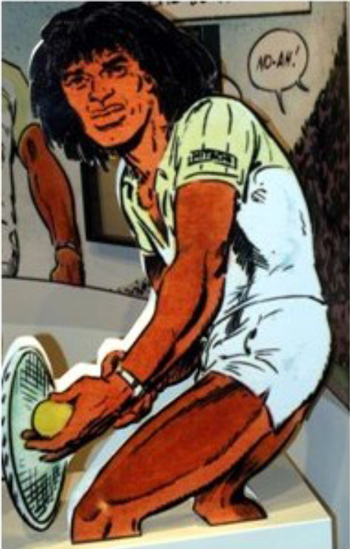VIEW AND DOWNLOAD WORLD TENNIS GAZETTE VOL. 12 NO. 10
By JOHN MARTIN

World Tennis Gazette/John Martin
PARIS — Every player takes tennis seriously at the French Open, but this year (2009), there’s a seriously comical side to the sport.
An exhibit called “Bulles et Balles” (Bubbles and Balls) delves deeply into 130 years of tennis cartoons and comic strip panels from the world’s magazines, newspapers and books.
The bubbles are those places in the strips where characters speak. The balls appear in many of the 143 panels displayed or cited by a full-color catalog that would be the envy of any curator in the world.
Navigating an elaborate maze of panels that form walkways below ground at the Tenniseum, the French tennis museum at Roland Garros, visitors see hundreds of images of tennis, from a 1615 depiction of Royal Court tennis in Leiden to the 20th century American favorites Mickey Mouse and Charlie Brown.
Snoopy’s two best lines are “I’m thinking seriously of not taking my tennis so seriously” and “I didn’t invent the double fault, I merely perfected it.”
“We rented those cartoons from the Shultz foundation,” Franck Lehodey said with a sly smile. He is an artist and former newspaperman who helped mount the exhibition for the French tennis federation.
One section displays Japanese depictions of tennis in a comic-book form called “manga.” A 38-year-old artist, Takeshi Konomi, created “The Prince of Tennis” in 1990, according to the catalog, which credits him with generating a tennis boom in Japan. His “Prince” now appears in musicals and video games, the catalog reports.
One pair of life-size cutouts, drawn by the French artist Andre Cheret, chronicles the events of Yannick Noah’s life leading up to his tumultu-ous triumph in the 1983 French Open final against Mats Wilander of Sweden.
In a series of smaller, newspaper-size panels, Cheret follows Noah from the African village where he was born to the moments after his victory at Ro-land Garros, where he runs to embrace his father, who has climbed down from the stands.
Titled “Once Upon a Time, Yannick Noah,” the panels are drawn in a style popular with millions of French readers who have followed Cheret’s cartoon character Rahan for 40 years. Con-ceived as a prehistoric man, Rahan’s metaphorical predecessors include Tarzan, cited by Cheret as a major inspiration.
“Yannick is an athlete that is full of life, like Rahan,” Cheret said in a catalog interview. “Many fans have actually asked me to draw Rahan with a racket.”
In keeping with his character’s prehistoric nature, Cheret drew Rahan brandishing a plank formed from a rubber tree as a racket and swing-ing at the sun for a ball.
Besides Noah, visitors see cartoon depictions of Suzanne Lenglen, Rene Lacoste, Bjorn Borg and Justine Henin.
Seriously.
This story originally appeared in the New York Times, June 5, 2009, under the title “The Art of Tennis, in Cartoons.”